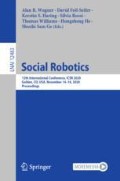Abstract
In this paper, we present a method of communicating affects from a remote user through the telepresence robot Haru. In this preliminary work, we transform the traditional mode of communicating text messages with emojis in the smartphone domain to the robot domain through robomojis- a hardware rendition of emojis. First we analyze human affects and expressions and synthesized these through the design of robomojis. Based on the telepresence robot Haru platform, we built a communication module that enables a remote user with a smartphone to send text and emoji messages to the robot. The robot then communicates these affectively through the rendition of robomojis. By exploiting the robot’s rich modality and through design, our preliminary results show that robomojis deliver better rendition than emojis. Although participants prefer the use of smartphones over telepresence robot due to convenience, our findings also show that they are willing to use the robomoji features in a telepresence robot such as Haru. This could enhance further the role of social robots as telepresence robots and open the possibility of integrating them to the traditional communication ecosystem.
Access this chapter
Tax calculation will be finalised at checkout
Purchases are for personal use only
References
Derks, D., Fischer, A.H., Bos, A.E.R.: The role of emotion in computer-mediated communication: a review. In: Proceedings of Computers in Human Behavior, pp. 766–785 (2008)
Kato, Y., Kato, S., Akahori, K.: Effects of emotional cues transmitted in e-mail communication on the emotions experienced by senders and receivers. In: Proceedings of Computers in Human Behavior, pp. 1894–1905 (2007)
Bethel, C.L., Murphy, R.R.: Survey of non-facial/non-verbal affective expressions for appearance-constrained robots. Proc. IEEE Trans. Syst. Man Cybern. Part C 38(1), 83–92 (2007)
Kristoffersson, A., Coradeschi, S., Loutfi, A.: A review of mobile robotic telepresence. Proc. Adv. Hum.-Comp. Int. 2013 (2013)
Shiarlis, et al.: Teresa: a socially intelligent semi-autonomous telepresence system. In: Workshop on Machine Learning for Social Robotics at ICRA (2015)
Orlandini, A., Kristoffersson, A., et al.: Excite project: a review of forty-two months of robotic telepresence technology evolution. In: Proceedings of the International Conference on Presence: Teleoperators and Virtual Environments (2017)
Reis, A., Martins, M., Martins, P., Sousa, J., Barroso, J.: Telepresence robots in the classroom: the state-of-the-art and a proposal for a telepresence service for higher education. In: Tsitouridou, M., A. Diniz, J., Mikropoulos, T.A. (eds.) TECH-EDU 2018. CCIS, vol. 993, pp. 539–550. Springer, Cham (2019). https://doi.org/10.1007/978-3-030-20954-4_41
Ogawa, K., et al.: Telenoid: tele-presence android for communication. In: Proceedings of ACM SIGGRAPH 2011 Emerging Technologies (2011)
Sakamoto, D., Kanda, T., Ono, T., Ishiguro, H., Hagita, N.: Android as a telecommunication medium with a human-like presence. In: Proceedings of the International Conference on Human-Robot Interaction (HRI), pp. 193–200 (2007)
Kawaguchi, et al.: Effect of embodiment presentation by humanoid robot on social telepresence. In: Proceedings of the International Conference on Human Agent Interaction, pp. 253–256 (2016)
Pan, Y., Steed, A.: A comparison of avatar-, video-, and robot-mediated interaction on users’ trust in expertise. Front. Robot. AI (2016)
Gomez, R., Szapiro, D., Galindo, K., Nakamura, K.: Haru: hardware design of an experimental tabletop robot assistant. In: Proceedings of the ACM/IEEE International Conference on Human-Robot Interaction (2018)
Gomez, R., Nakamura, K., Szapiro, D., Merino, L.: A holistic approach in designing tabletop robot’s expressivity. In: Proceedings of the IEEE International Conference on Robotics and Automation (2020)
Norrick, N.: Language play in conversation. In: Bell, N. (ed.) Multiple Perspectives on Language Play, pp. 11–45 (2016)
Dienar, D., et al.: Youth and Language Play in Style and Intersubjectivity in Youth Interaction. Contributions to the Sociology of Language (2018)
Kelly, R., Watts, L.: Characterising the inventive appropriation of emoji as relationally meaningful in mediated personal relationships. In: Proceeding to the International Conference of Experiences of Technology Appropriation: Unanticipated Users, Usage, Circumstances, and Design (2015)
Dourish, P.: Where the Action Is. MIT Press, Cambridge (2001)
Janik, S.W., Wellens, A.R., Goldberg, M.L., Dell’Osso, L.F., Skills, M.: Eyes as the center of focus in the visual examination of human faces (1978)
Wei, L., Deng, Z.: A practical model for live speech-driven lip-sync. In: Proceedings of the IEEE Computer Graphics and Applications, pp. 70–78 (2015)
Hutto, C., Gilbert, E.: Vader: a parsimonious rule-based model for sentiment analysis of social media text. In: Proceedings of the Eighth International Conference on Weblogs and Social Media (ICWSM) (2014)
Acknowledgement
We would like to thank Paulo Alvito of IDMIND, Kerl Galindo of UTS, Fernando Caballero, Alvaro Paez, and Ricardo Ragel De la Torre of UPO for their contributions.
Author information
Authors and Affiliations
Corresponding authors
Editor information
Editors and Affiliations
Rights and permissions
Copyright information
© 2020 Springer Nature Switzerland AG
About this paper
Cite this paper
Gomez, R., Szapiro, D., Merino, L., Brock, H., Nakamura, K., Sabanovic, S. (2020). Emoji to Robomoji: Exploring Affective Telepresence Through Haru. In: Wagner, A.R., et al. Social Robotics. ICSR 2020. Lecture Notes in Computer Science(), vol 12483. Springer, Cham. https://doi.org/10.1007/978-3-030-62056-1_54
Download citation
DOI: https://doi.org/10.1007/978-3-030-62056-1_54
Published:
Publisher Name: Springer, Cham
Print ISBN: 978-3-030-62055-4
Online ISBN: 978-3-030-62056-1
eBook Packages: Computer ScienceComputer Science (R0)

